NETGEAR WNR200v4 User Manual
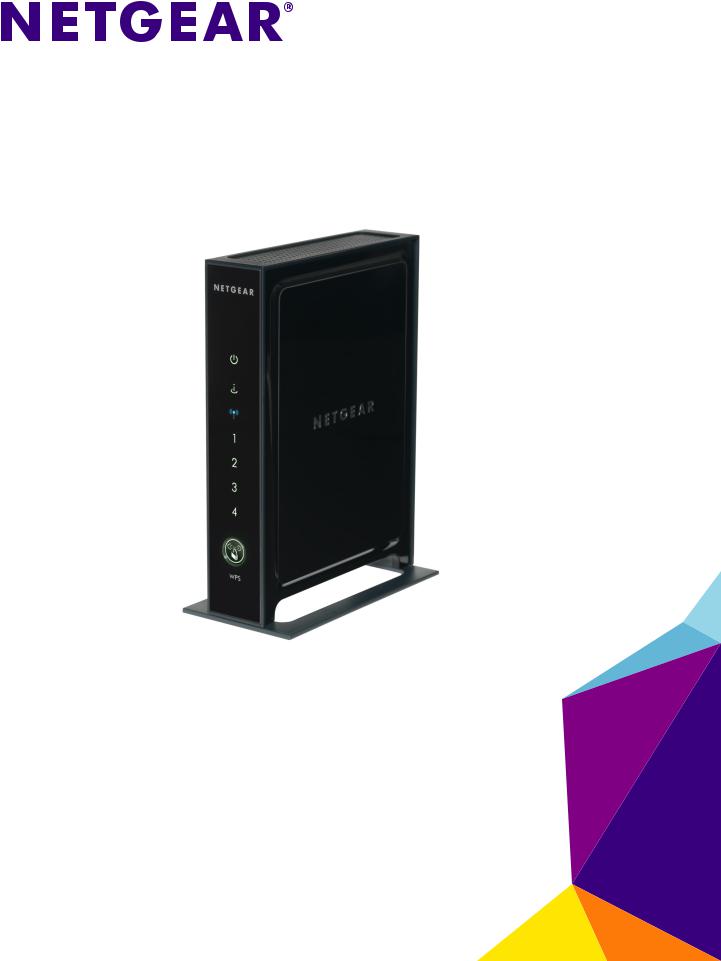
N300 Wireless Router WNR2000v4
User Manual
March 2014 202-11229-03
350 East Plumeria Drive
San Jose, CA 95134
USA

N300 Wireless Router WNR2000v4
Support
Thank you for selecting NETGEAR products.
After installing your device, locate the serial number on the label of your product and use it to register your product at https://my.netgear.com. You must register your product before you can use NETGEAR telephone support. NETGEAR recommends registering your product through the NETGEAR website. For product updates and web support, visit http://support.netgear.com.
Phone (US & Canada only): 1-888-NETGEAR.
Phone (Other Countries): Check the list of phone numbers at http://support.netgear.com/general/contact/default.aspx.
Compliance
For regulatory compliance information, visit http://www.netgear.com/about/regulatory.
See the regulatory compliance document before connecting the power supply.
Trademarks
NETGEAR, the NETGEAR logo, and Connect with Innovation are trademarks and/or registered trademarks of NETGEAR, Inc. and/or its subsidiaries in the United States and/or other countries. Information is subject to change without notice.
© NETGEAR, Inc. All rights reserved.
2

Contents
Chapter 1 Hardware Setup
Unpack Your Router . . . . . . . . . . . . . . . . . . . . . . . . . . . . . . . . . . . . . . . . . . . . . . . . . . 8
Hardware Features . . . . . . . . . . . . . . . . . . . . . . . . . . . . . . . . . . . . . . . . . . . . . . . . . . . 8
Front Panel . . . . . . . . . . . . . . . . . . . . . . . . . . . . . . . . . . . . . . . . . . . . . . . . . . . . . . . . 9
Back Panel . . . . . . . . . . . . . . . . . . . . . . . . . . . . . . . . . . . . . . . . . . . . . . . . . . . . . . . 11
Label . . . . . . . . . . . . . . . . . . . . . . . . . . . . . . . . . . . . . . . . . . . . . . . . . . . . . . . . . . . . 12
Position Your Router . . . . . . . . . . . . . . . . . . . . . . . . . . . . . . . . . . . . . . . . . . . . . . . . . 12
Cable Your Router . . . . . . . . . . . . . . . . . . . . . . . . . . . . . . . . . . . . . . . . . . . . . . . . . . . 14
Verify the Cabling . . . . . . . . . . . . . . . . . . . . . . . . . . . . . . . . . . . . . . . . . . . . . . . . . . . 15
Chapter 2 Getting Started with NETGEAR genie
Router Setup Preparation. . . . . . . . . . . . . . . . . . . . . . . . . . . . . . . . . . . . . . . . . . . . . 17 Use Standard TCP/IP Properties for DHCP . . . . . . . . . . . . . . . . . . . . . . . . . . . . 17 Gather ISP Information . . . . . . . . . . . . . . . . . . . . . . . . . . . . . . . . . . . . . . . . . . . . 17 Wireless Devices and Security Settings. . . . . . . . . . . . . . . . . . . . . . . . . . . . . . . 17 Types of Logins and Access . . . . . . . . . . . . . . . . . . . . . . . . . . . . . . . . . . . . . . . . . . . 17 NETGEAR genie Setup. . . . . . . . . . . . . . . . . . . . . . . . . . . . . . . . . . . . . . . . . . . . . . . . 18 Use NETGEAR genie after Installation . . . . . . . . . . . . . . . . . . . . . . . . . . . . . . . . . . 18 Upgrade Router Firmware . . . . . . . . . . . . . . . . . . . . . . . . . . . . . . . . . . . . . . . . . . . . 19 Router Dashboard (Basic Home Screen) . . . . . . . . . . . . . . . . . . . . . . . . . . . . . . . . 20 Change the Password . . . . . . . . . . . . . . . . . . . . . . . . . . . . . . . . . . . . . . . . . . . . . . . . 21 Password Recovery . . . . . . . . . . . . . . . . . . . . . . . . . . . . . . . . . . . . . . . . . . . . . . . . . . 22 Add Wireless Devices or Computers to Your Network . . . . . . . . . . . . . . . . . . . . 22 Manual Method . . . . . . . . . . . . . . . . . . . . . . . . . . . . . . . . . . . . . . . . . . . . . . . . . . . 22 Wi-Fi Protected Setup (WPS) Method . . . . . . . . . . . . . . . . . . . . . . . . . . . . . . . 23
Chapter 3 genie Basic Settings
Internet Setup . . . . . . . . . . . . . . . . . . . . . . . . . . . . . . . . . . . . . . . . . . . . . . . . . . . . . . 25
Internet Setup Screen Fields . . . . . . . . . . . . . . . . . . . . . . . . . . . . . . . . . . . . . . . . 26
Basic Wireless Settings . . . . . . . . . . . . . . . . . . . . . . . . . . . . . . . . . . . . . . . . . . . . . . . 27
Wireless Settings Screen Fields. . . . . . . . . . . . . . . . . . . . . . . . . . . . . . . . . . . . . . 29
WPA-PSK, WPA2-PSK, and WPA-PSK + WPA2-PSK Mixed Mode. . . . . . . . 30
WPA/WPA2 Enterprise . . . . . . . . . . . . . . . . . . . . . . . . . . . . . . . . . . . . . . . . . . . . 31
WEP. . . . . . . . . . . . . . . . . . . . . . . . . . . . . . . . . . . . . . . . . . . . . . . . . . . . . . . . . . . . . 31
Attached Devices. . . . . . . . . . . . . . . . . . . . . . . . . . . . . . . . . . . . . . . . . . . . . . . . . . . . 33
Parental Controls . . . . . . . . . . . . . . . . . . . . . . . . . . . . . . . . . . . . . . . . . . . . . . . . . . . . 34
Guest Network. . . . . . . . . . . . . . . . . . . . . . . . . . . . . . . . . . . . . . . . . . . . . . . . . . . . . . 38
3

N300 Wireless Router WNR2000v4
Chapter 4 genie Advanced Home
Setup Wizard . . . . . . . . . . . . . . . . . . . . . . . . . . . . . . . . . . . . . . . . . . . . . . . . . . . . . . . 42 WPS Wizard . . . . . . . . . . . . . . . . . . . . . . . . . . . . . . . . . . . . . . . . . . . . . . . . . . . . . . . . 43 Setup Menu . . . . . . . . . . . . . . . . . . . . . . . . . . . . . . . . . . . . . . . . . . . . . . . . . . . . . . . . 44 WAN Setup . . . . . . . . . . . . . . . . . . . . . . . . . . . . . . . . . . . . . . . . . . . . . . . . . . . . . . . . . 45 WAN Setup Screen Settings . . . . . . . . . . . . . . . . . . . . . . . . . . . . . . . . . . . . . . . . 45 Default DMZ Server . . . . . . . . . . . . . . . . . . . . . . . . . . . . . . . . . . . . . . . . . . . . . . . 46 Change the MTU Size . . . . . . . . . . . . . . . . . . . . . . . . . . . . . . . . . . . . . . . . . . . . . . 47 LAN Setup. . . . . . . . . . . . . . . . . . . . . . . . . . . . . . . . . . . . . . . . . . . . . . . . . . . . . . . . . . 48 LAN Setup Screen Settings . . . . . . . . . . . . . . . . . . . . . . . . . . . . . . . . . . . . . . . . . 49 Manage the DHCP Server on the Router . . . . . . . . . . . . . . . . . . . . . . . . . . . . . 50 Set Up Address Reservation . . . . . . . . . . . . . . . . . . . . . . . . . . . . . . . . . . . . . . . . 51 QoS Setup. . . . . . . . . . . . . . . . . . . . . . . . . . . . . . . . . . . . . . . . . . . . . . . . . . . . . . . . . . 53 Wi-Fi Multimedia Quality of Service for Wireless Traffic . . . . . . . . . . . . . . . . 53 Optimize Internet Gaming with Upstream QoS . . . . . . . . . . . . . . . . . . . . . . . . 53 Quality of Service Priority Rules and Internet Access. . . . . . . . . . . . . . . . . . . 54
Chapter 5 Security
Keyword Blocking of HTTP Traffic . . . . . . . . . . . . . . . . . . . . . . . . . . . . . . . . . . . . . 62 Exempt a Computer from Blocking and Logging . . . . . . . . . . . . . . . . . . . . . . . 63 Block Services (Port Filtering). . . . . . . . . . . . . . . . . . . . . . . . . . . . . . . . . . . . . . . . . 63 Schedule Blocking . . . . . . . . . . . . . . . . . . . . . . . . . . . . . . . . . . . . . . . . . . . . . . . . . . . 66 Security Event Email Notifications . . . . . . . . . . . . . . . . . . . . . . . . . . . . . . . . . . . . . 67 Allow or Block Access to Your Network . . . . . . . . . . . . . . . . . . . . . . . . . . . . . . . . . 68 View or Add Allowed Devices Not Connected to the Network . . . . . . . . . . . 70 View or Add Blocked Devices Not Connected to the Network . . . . . . . . . . . 71
Chapter 6 Administration
Upgrade the Router Firmware . . . . . . . . . . . . . . . . . . . . . . . . . . . . . . . . . . . . . . . . . 74
View and Configure Logs . . . . . . . . . . . . . . . . . . . . . . . . . . . . . . . . . . . . . . . . . . . . . 75
Manage the Configuration File . . . . . . . . . . . . . . . . . . . . . . . . . . . . . . . . . . . . . . . . 76
Back Up Settings . . . . . . . . . . . . . . . . . . . . . . . . . . . . . . . . . . . . . . . . . . . . . . . . . . 76
Restore Configuration Settings. . . . . . . . . . . . . . . . . . . . . . . . . . . . . . . . . . . . . . 77
Erase . . . . . . . . . . . . . . . . . . . . . . . . . . . . . . . . . . . . . . . . . . . . . . . . . . . . . . . . . . . . 77
Chapter 7 Advanced Settings
Advanced Wireless Settings. . . . . . . . . . . . . . . . . . . . . . . . . . . . . . . . . . . . . . . . . . . 80
Advanced Settings for Your Wireless Network. . . . . . . . . . . . . . . . . . . . . . . . . 80
Set Up a Wireless Schedule . . . . . . . . . . . . . . . . . . . . . . . . . . . . . . . . . . . . . . . . . 81
Set Up the WPS Settings . . . . . . . . . . . . . . . . . . . . . . . . . . . . . . . . . . . . . . . . . . . 82
Wireless Access Point (AP). . . . . . . . . . . . . . . . . . . . . . . . . . . . . . . . . . . . . . . . . . . . 83
Wireless Distribution System (WDS) . . . . . . . . . . . . . . . . . . . . . . . . . . . . . . . . . . . 84
Set Up the Base Station . . . . . . . . . . . . . . . . . . . . . . . . . . . . . . . . . . . . . . . . . . . . 86
Set Up a Repeater . . . . . . . . . . . . . . . . . . . . . . . . . . . . . . . . . . . . . . . . . . . . . . . . . 87
Port Forwarding and Port Triggering Configuration Concepts. . . . . . . . . . . . . . 89
4

N300 Wireless Router WNR2000v4
Remote Computer Access Basics . . . . . . . . . . . . . . . . . . . . . . . . . . . . . . . . . . . . 89 Port Triggering to Open Incoming Ports . . . . . . . . . . . . . . . . . . . . . . . . . . . . . . 90 Port Forwarding to Permit External Host Communications . . . . . . . . . . . . . . 91 How Port Forwarding Differs from Port Triggering. . . . . . . . . . . . . . . . . . . . . 92 Set Up Port Forwarding to Local Servers. . . . . . . . . . . . . . . . . . . . . . . . . . . . . . . . 93 Add a Custom Service . . . . . . . . . . . . . . . . . . . . . . . . . . . . . . . . . . . . . . . . . . . . . 94 Edit or Delete a Port Forwarding Entry . . . . . . . . . . . . . . . . . . . . . . . . . . . . . . . 95 Application Example: Make a Local Web Server Public . . . . . . . . . . . . . . . . . . 95 Set Up Port Triggering . . . . . . . . . . . . . . . . . . . . . . . . . . . . . . . . . . . . . . . . . . . . . . . 96 Dynamic DNS . . . . . . . . . . . . . . . . . . . . . . . . . . . . . . . . . . . . . . . . . . . . . . . . . . . . . . . 99 Static Routes . . . . . . . . . . . . . . . . . . . . . . . . . . . . . . . . . . . . . . . . . . . . . . . . . . . . . . 101 Remote Management . . . . . . . . . . . . . . . . . . . . . . . . . . . . . . . . . . . . . . . . . . . . . . . 103 Universal Plug and Play. . . . . . . . . . . . . . . . . . . . . . . . . . . . . . . . . . . . . . . . . . . . . . 104 IPv6 . . . . . . . . . . . . . . . . . . . . . . . . . . . . . . . . . . . . . . . . . . . . . . . . . . . . . . . . . . . . . . 106 Requirements for Entering IPv6 Addresses. . . . . . . . . . . . . . . . . . . . . . . . . . . 107 IPv6 Auto Detect . . . . . . . . . . . . . . . . . . . . . . . . . . . . . . . . . . . . . . . . . . . . . . . . 107 IPv6 Auto Config. . . . . . . . . . . . . . . . . . . . . . . . . . . . . . . . . . . . . . . . . . . . . . . . . 108 IPv6 6to4 Tunnel. . . . . . . . . . . . . . . . . . . . . . . . . . . . . . . . . . . . . . . . . . . . . . . . . 110 IPv6 Pass Through. . . . . . . . . . . . . . . . . . . . . . . . . . . . . . . . . . . . . . . . . . . . . . . . 111 IPv6 Fixed. . . . . . . . . . . . . . . . . . . . . . . . . . . . . . . . . . . . . . . . . . . . . . . . . . . . . . . 111 IPv6 DHCP . . . . . . . . . . . . . . . . . . . . . . . . . . . . . . . . . . . . . . . . . . . . . . . . . . . . . . 113 IPv6 PPPoE. . . . . . . . . . . . . . . . . . . . . . . . . . . . . . . . . . . . . . . . . . . . . . . . . . . . . . 114 Traffic Meter . . . . . . . . . . . . . . . . . . . . . . . . . . . . . . . . . . . . . . . . . . . . . . . . . . . . . . 115
Chapter 8 Monitoring
Router Status and Usage Information Screen . . . . . . . . . . . . . . . . . . . . . . . . . . . 119
Router Information Pane . . . . . . . . . . . . . . . . . . . . . . . . . . . . . . . . . . . . . . . . . . . . 120
Internet Port Pane . . . . . . . . . . . . . . . . . . . . . . . . . . . . . . . . . . . . . . . . . . . . . . . . . . 120
Statistics. . . . . . . . . . . . . . . . . . . . . . . . . . . . . . . . . . . . . . . . . . . . . . . . . . . . . . . . 121
Connection Status. . . . . . . . . . . . . . . . . . . . . . . . . . . . . . . . . . . . . . . . . . . . . . . . 122
Wireless Settings Pane . . . . . . . . . . . . . . . . . . . . . . . . . . . . . . . . . . . . . . . . . . . . . . 123
Guest Network Pane . . . . . . . . . . . . . . . . . . . . . . . . . . . . . . . . . . . . . . . . . . . . . . . . 124
Chapter 9 Troubleshooting
Quick Tips . . . . . . . . . . . . . . . . . . . . . . . . . . . . . . . . . . . . . . . . . . . . . . . . . . . . . . . . . 126 Sequence to Restart Your Network . . . . . . . . . . . . . . . . . . . . . . . . . . . . . . . . . 126 Check Ethernet Cable Connections . . . . . . . . . . . . . . . . . . . . . . . . . . . . . . . . . 126 Wireless Settings. . . . . . . . . . . . . . . . . . . . . . . . . . . . . . . . . . . . . . . . . . . . . . . . . 126 Network Settings . . . . . . . . . . . . . . . . . . . . . . . . . . . . . . . . . . . . . . . . . . . . . . . . 126
Troubleshoot with the LEDs . . . . . . . . . . . . . . . . . . . . . . . . . . . . . . . . . . . . . . . . . . 127 Power LED Is Off or Blinking . . . . . . . . . . . . . . . . . . . . . . . . . . . . . . . . . . . . . . . 127 Power LED Stays Amber . . . . . . . . . . . . . . . . . . . . . . . . . . . . . . . . . . . . . . . . . . 127 All LEDs Remain Lit after Startup . . . . . . . . . . . . . . . . . . . . . . . . . . . . . . . . . . . 127 Internet or LAN Port LEDs Are Off. . . . . . . . . . . . . . . . . . . . . . . . . . . . . . . . . . 128 Wireless LED Is Off . . . . . . . . . . . . . . . . . . . . . . . . . . . . . . . . . . . . . . . . . . . . . . . 128 The WPS (Push 'N' Connect) Button Blinks Amber . . . . . . . . . . . . . . . . . . . . 128
Cannot Log In to the Router. . . . . . . . . . . . . . . . . . . . . . . . . . . . . . . . . . . . . . . . . . 129
5

N300 Wireless Router WNR2000v4
Cannot Access the Internet . . . . . . . . . . . . . . . . . . . . . . . . . . . . . . . . . . . . . . . . . . 129
Troubleshoot Internet Browsing . . . . . . . . . . . . . . . . . . . . . . . . . . . . . . . . . . . . 130
Troubleshoot a PPPoE Internet Connection . . . . . . . . . . . . . . . . . . . . . . . . . . 131
Changes Not Saved . . . . . . . . . . . . . . . . . . . . . . . . . . . . . . . . . . . . . . . . . . . . . . . . . 131
Wireless Connectivity . . . . . . . . . . . . . . . . . . . . . . . . . . . . . . . . . . . . . . . . . . . . . . . 132
Wireless Signal Strength . . . . . . . . . . . . . . . . . . . . . . . . . . . . . . . . . . . . . . . . . . 132
Troubleshoot Your Network Using the Ping Utility . . . . . . . . . . . . . . . . . . . . . . . 132
Test the LAN Path to Your Router. . . . . . . . . . . . . . . . . . . . . . . . . . . . . . . . . . . 132
Test the Path from Your Computer to a Remote Device . . . . . . . . . . . . . . . . 133
Appendix A Supplemental Information
Factory Settings . . . . . . . . . . . . . . . . . . . . . . . . . . . . . . . . . . . . . . . . . . . . . . . . . . . 136
Technical Specifications . . . . . . . . . . . . . . . . . . . . . . . . . . . . . . . . . . . . . . . . . . . . . 137
Index
6

1. Hardware Setup |
1 |
Get to know your router |
If you have not already set up your new router using the installation guide that comes in the box, this chapter walks you through the hardware setup. Chapter 2, Getting Started with NETGEAR genie, explains how to set up your Internet connection.
This chapter contains the following sections:
•Unpack Your Router
•Hardware Features
•Position Your Router
•Cable Your Router
•Verify the Cabling
For more information about the topics covered in this manual, visit the support website at http://support.netgear.com.
Firmware updates with new features and bug fixes are made available from time to time on downloadcenter.netgear.com. Some products can regularly check the site and download new firmware, or you can check for and download new firmware manually. If the features or behavior of your product does not match what is described in this guide, you might need to update your firmware.
7
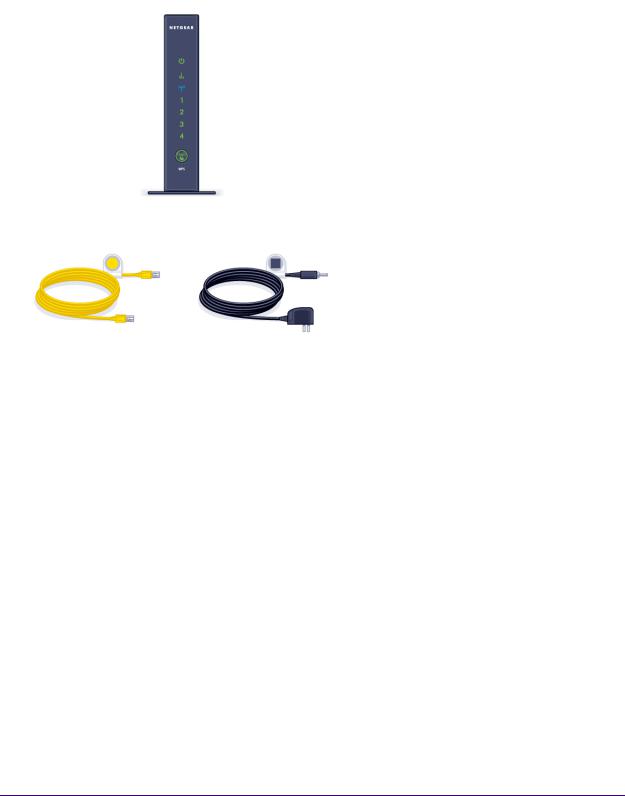
N300 Wireless Router WNR2000v4
Unpack Your Router
Open the box and remove the router, cables, and installation guide.
N300 Wireless Router
Ethernet cable |
Power adapter |
Figure 1. Package contents
Your box contains the following items:
•N300 Wireless Router WNR2000v4
•AC power adapter (plug varies by region)
•Category 5e (Cat 5E) Ethernet cable
•Installation guide
If any parts are incorrect, missing, or damaged, contact your NETGEAR dealer. Keep the carton and original packing materials, in case you need to return the product for repair.
Hardware Features
Before you cable your router, take a moment to become familiar with the label and the front and back panels. Pay particular attention to the LEDs on the front panel.
Hardware Setup
8
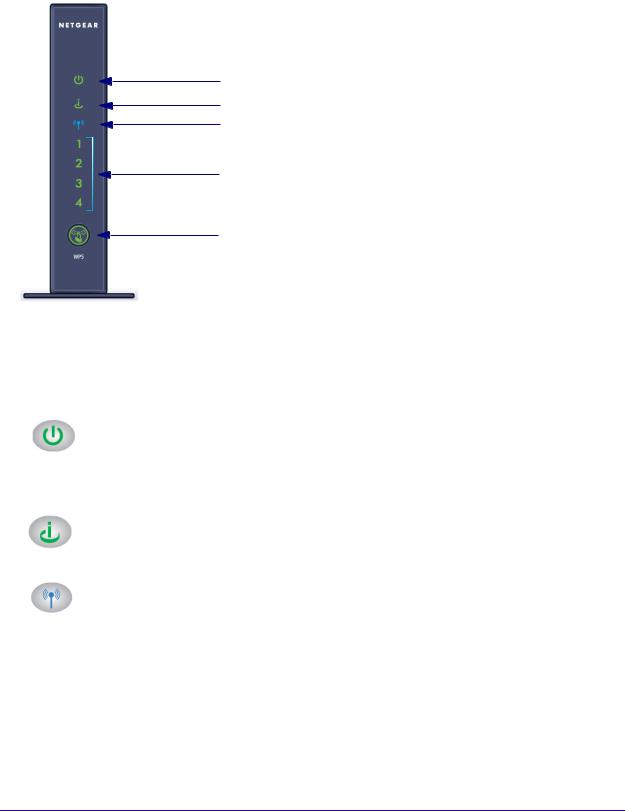
N300 Wireless Router WNR2000v4
Front Panel
The router front panel has the following status LEDs and button:
Power LED
Internet LED
Wireless LED
LAN LEDs
WPS button and LED
Figure 2. Front panel
Table 1. Front panel LED descriptions
LED |
Description |
|
|
Power |
• Solid amber. The unit is starting up after being powered on. |
|
• Solid green. The power is on, and the router is ready. |
|
• Blinking amber. A firmware update is in progress. |
|
• Blinking green. The firmware is corrupt. |
|
• Off. Power is not supplied to the router. |
Internet |
• Solid amber. The IP address has not been acquired. |
|
• Solid green. An IP address has been received; ready to transmit data. |
|
• Off. No Ethernet cable is connected between the router and the modem. |
|
|
Wireless |
• Solid blue. The wireless radio is operating. |
|
|
|
• Off. The wireless radio is off. |
|
|
Hardware Setup
9

N300 Wireless Router WNR2000v4
Table 1. Front panel LED descriptions (continued)
LED |
Description |
|
|
LAN ports |
• Solid green. The LAN port has detected a 100 Mbps link with an attached device. |
1–4 |
|
|
• Solid amber. The LAN port has detected a 10 Mbps link with an attached device. |
|
• Off. No link is detected on the LAN port. |
|
|
WPS |
• Solid green. Indicates that wireless security is enabled. |
|
• Blinking green. The router is attempting to use WPS to add a wireless device or computer to |
|
the wireless network. |
|
• Blinking green rapidly for about 5 seconds. WPS has failed to add a wireless device or |
|
computer. |
|
• Blinking green rapidly and continuously. The router is in stuck in the temporary AP setup |
|
locked state. For more information, see The WPS (Push 'N' Connect) Button Blinks Amber on |
|
page 128. |
|
• Off. No WPS connection exists. |
|
|
Hardware Setup
10
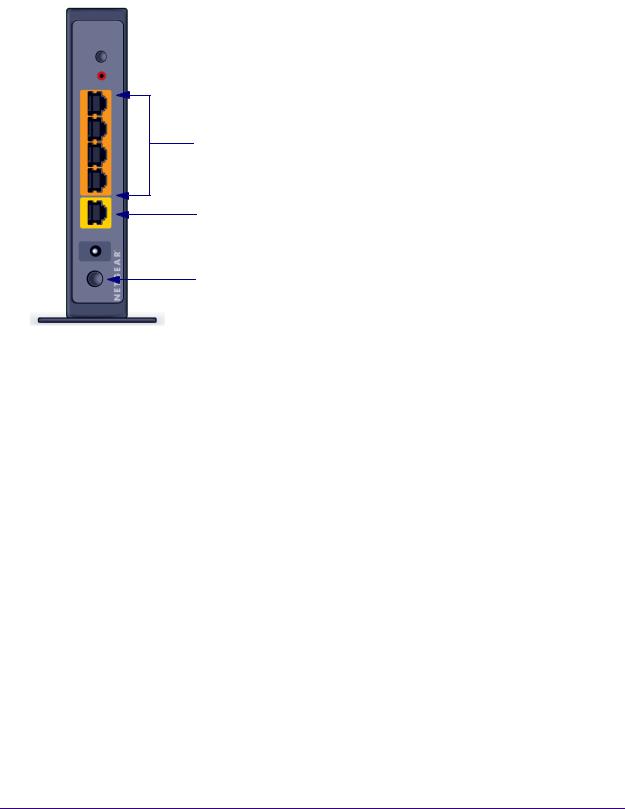
N300 Wireless Router WNR2000v4
Back Panel
The back panel has the following buttons, ports, and connector:
 WiFi On/Off button
WiFi On/Off button
 Restore Factory Settings button
Restore Factory Settings button
LAN ports
Internet port
 AC power connector
AC power connector
On/Off button
Figure 3. Back panel
Table 2. Back panel button, port, and connector descriptions
Port or Button |
Description |
|
|
WiFi On/Off button |
Turns the wireless radio in the router on or off. |
|
|
Restore Factory Settings button |
Press and hold this button for about 7 seconds to reset the router to its |
|
factory default settings. |
|
|
LAN ports |
Four local area network (LAN) 10/100 Mbps Ethernet ports for connecting the |
|
router to your local computers. |
|
|
Internet port |
Ethernet port for connecting the router to a cable broadband modem or DSL |
|
broadband modem. The Internet port is also referred to as the WAN port. |
|
|
AC power connector |
AC power connector to connect the power adapter to the router. |
|
|
Power On/Off button |
Turns the router on or off. |
|
|
Hardware Setup
11
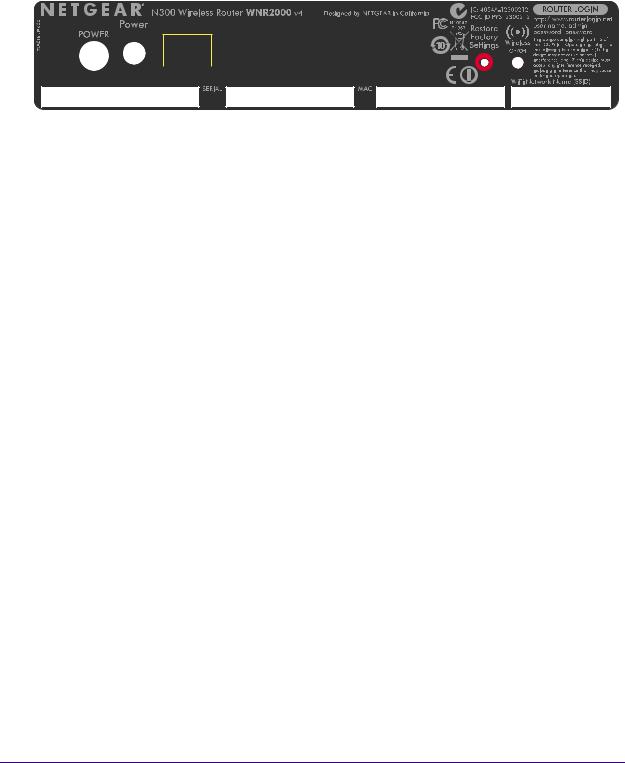
N300 Wireless Router WNR2000v4
Label
The label on the back panel of the router shows the default login information, default WiFi network name (SSID), network key (also referred to as wireless network password or passphrase), serial number, MAC address, and other information.








 China in Made
China in Made
Figure 4. Label on the back panel
For information about restoring factory settings, see Factory Settings on page 136.
Position Your Router
The router lets you access your network from virtually anywhere within the operating range of your wireless network. However, the operating distance or range of your wireless connection can vary significantly depending on the physical placement of your router. For example, the thickness and number of walls the wireless signal passes through can limit the range. For best results, place your router:
•Near the center of the area where your computers and other devices operate, and preferably within line of sight to your wireless devices.
•So it is accessible to an AC power outlet and near Ethernet cables for wired computers.
•In an elevated location such as a high shelf, keeping the number of walls and ceilings between the router and your other devices to a minimum.
•Away from electrical devices that are potential sources of interference, such as ceiling fans, home security systems, microwaves, computers, or the base of a cordless phone or 2.4 GHz cordless phone.
•Away from any large metal surfaces, such as a solid metal door or aluminum studs. Large expanses of other materials such as glass, insulated walls, fish tanks, mirrors, brick, and concrete can also affect your wireless signal.
Hardware Setup
12
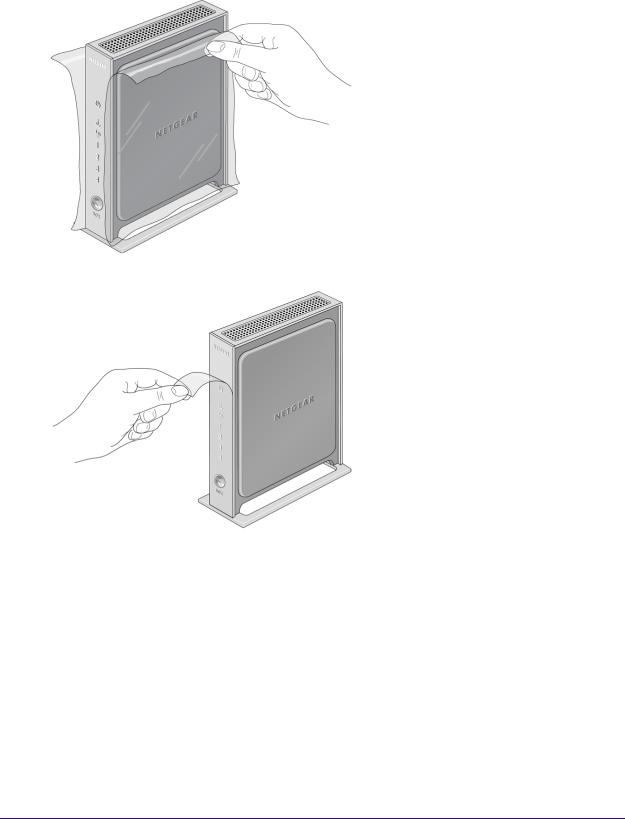
N300 Wireless Router WNR2000v4
To prepare your router for installation:
1. Carefully peel off the protective film covering both sides of your router.
2. Remove the protective film covering the front panel of the router.
3.Place your router in a suitable area for installation (near an AC power outlet and accessible to the Ethernet cables for your wired computers).
Hardware Setup
13
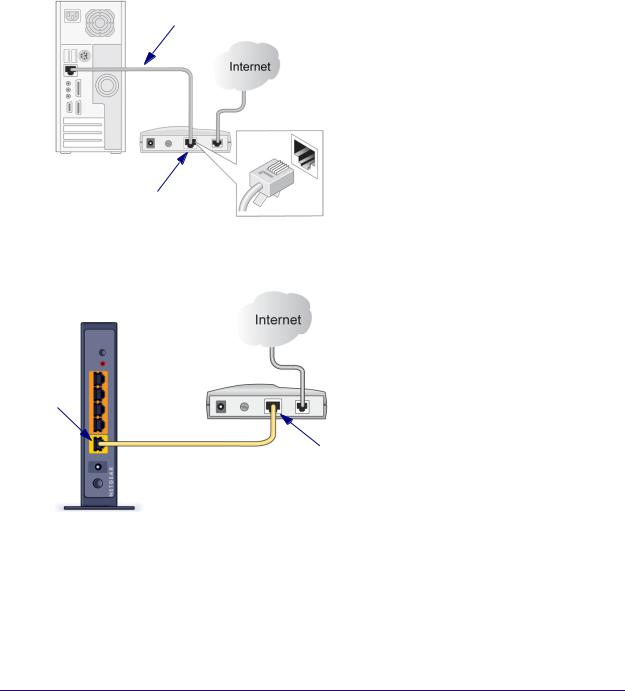
N300 Wireless Router WNR2000v4
Cable Your Router
The installation guide that came in the box has a cabling diagram on the first page. This section describes how to connect the router, the computer, and the cable or DSL broadband modem, and provides detailed illustrations.
1.Turn off and unplug the cable or DSL broadband modem. If your modem has a backup battery, remove it as well.
2.Locate the Ethernet cable (1) that connects your computer to the modem.
1
2
3.Disconnect the cable from the modem (2). You will connect it to the router later.
4.Locate the Ethernet cable that came with the NETGEAR product. Securely insert the Ethernet cable into your modem and into the Internet port of the router.
Hardware Setup
14
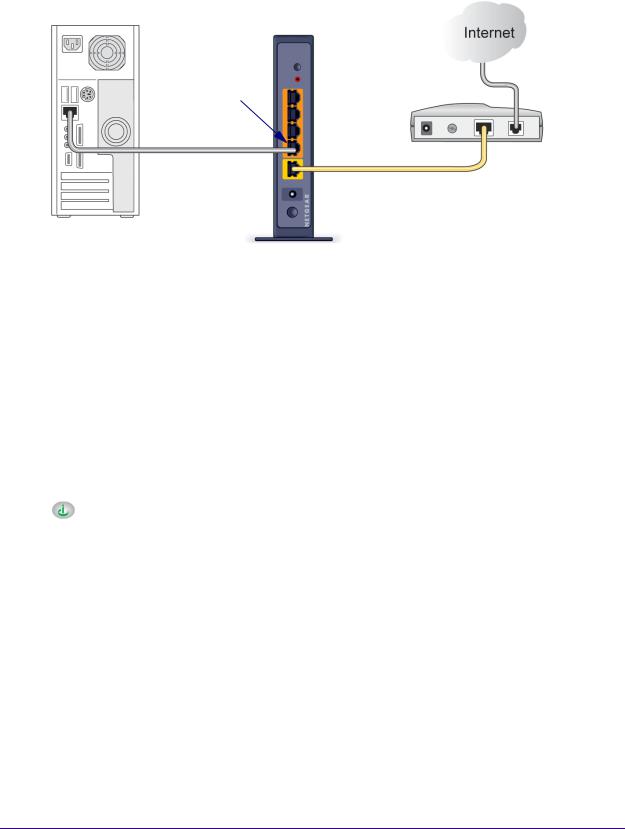
N300 Wireless Router WNR2000v4
5.Locate the cable you removed from the modem in Step 3. Securely insert that cable into a LAN port on the router such as LAN port 4.
Your network cables are connected, and you are ready to start your network. It is important that you start your network in the correct sequence:
1.First, power on the modem.
2.After the modem finishes starting up, power on the router. Turn on the router by pressing the Power On/Off button on the back.
Verify the Cabling
Verify that your router is cabled correctly by checking the router LEDs:
• The Power LED is solid green when the router is turned on.
The Power LED is solid green when the router is turned on.
• The Wireless LED is solid blue.
The Wireless LED is solid blue.
•The Internet LED is solid green. If it is not, make sure that the Ethernet cable is securely attached to the router Internet port, and that the modem is powered on.
• The LAN LEDs (1 through 4) are solid green or solid amber for any computers cabled to the router by an Ethernet cable.
The LAN LEDs (1 through 4) are solid green or solid amber for any computers cabled to the router by an Ethernet cable.
Hardware Setup
15

2. Getting Started with NETGEAR |
2 |
|
|
||
|
genie |
|
|
|
|
Connect to the router
This chapter explains how to use NETGEAR genie to set up your router after you complete cabling as described in the installation guide and in the previous chapter in this book.
This chapter contains the following sections:
•Router Setup Preparation
•Types of Logins and Access
•NETGEAR genie Setup
•Use NETGEAR genie after Installation
•Upgrade Router Firmware
•Router Dashboard (Basic Home Screen)
•Change the Password
•Password Recovery
•Add Wireless Devices or Computers to Your Network
16

N300 Wireless Router WNR2000v4
Router Setup Preparation
You can set up your router with NETGEAR genie automatically, or you can use the genie menus and screens to set up your router manually. However, before you start the setup process, you need to have your ISP information on hand and make sure the laptops, computers, and other devices in the network have the settings described here.
Use Standard TCP/IP Properties for DHCP
If you set up your computer to use a static IP address, you need to change the settings so that it uses Dynamic Host Configuration Protocol (DHCP).
Gather ISP Information
If you have DSL broadband service, you might need the following information to set up your router and to check that your Internet configuration is correct. Your Internet service provider (ISP) should have provided you with all of the information needed to connect to the Internet. If you cannot locate this information, ask your ISP to provide it. When your Internet connection is working, you no longer need to launch the ISP’s login program on your computer to access the Internet. When you start an Internet application, your router automatically logs you in.
•The ISP configuration information for your DSL account
•ISP login name and password
•Fixed or static IP address settings (special deployment by ISP; this is rare)
Wireless Devices and Security Settings
Make sure that the wireless device or computer that you are using supports WPA or WPA2 wireless security, which is the wireless security supported by the router. For information about the router’s preconfigured security settings, see Basic Wireless Settings on page 27.
Types of Logins and Access
There are separate types of logins that have different purposes. It is important that you understand the difference so that you know which login to use when.
•Router login logs you in to the router user interface from NETGEAR genie. For more information, see Use NETGEAR genie after Installation on page 18.
•ISP login logs you in to your Internet service. Your service provider has provided you with this login information in a letter or some other way. If you cannot find this login information, contact your service provider.
•Wireless network login. Your router is preset with a unique wireless network name (SSID) and password for wireless access. This information is on the label located on the back of your router.
Getting Started with NETGEAR genie
17

N300 Wireless Router WNR2000v4
NETGEAR genie Setup
NETGEAR genie runs on any device with a web browser. It is the easiest way to set up the router because it automates many of the steps and verifies that those steps have been successfully completed. It takes about 15 minutes to complete.
To use NETGEAR genie to set up your router:
1.Turn the router on by pressing the Power On/Off button, if not done yet.
2.Make sure that your device is connected with an Ethernet cable to your router.
3.Launch your Internet browser.
•If this is the first time you are setting up the Internet connection for your router, the browser automatically goes to http://www.routerlogin.net, and the NETGEAR genie screen displays.
•If you already used NETGEAR genie, type http://www.routerlogin.net in the address field for your browser to display the NETGEAR genie screen. For more information, see Use NETGEAR genie after Installation on page 18.
4.Follow the onscreen instructions to complete the NETGEAR genie setup. NETGEAR genie guides you through connecting the router to the Internet.
If the browser cannot display the web page:
•Make sure that the computer is connected to one of the four LAN Ethernet ports, or wirelessly to the router.
•Make sure that the router is fully up and running. Its Wireless LED should be lit.
•Close and reopen the browser to make sure that the browser does not cache the previous page.
•Browse to http://routerlogin.net.
•If the computer is set to a static or fixed IP address (this is uncommon), change it to obtain an IP address automatically from the router.
If the router does not connect to the Internet:
1.Review the router’s settings to be sure that you have selected the correct options and typed everything correctly.
2.Contact your ISP to verify that you have the correct configuration information.
3.Read Chapter 9, Troubleshooting. If problems persist, register your NETGEAR product and contact NETGEAR technical support.
Use NETGEAR genie after Installation
When you first set up your router, NETGEAR genie automatically starts when you launch an Internet browser on a computer that is connected to the router.
Getting Started with NETGEAR genie
18
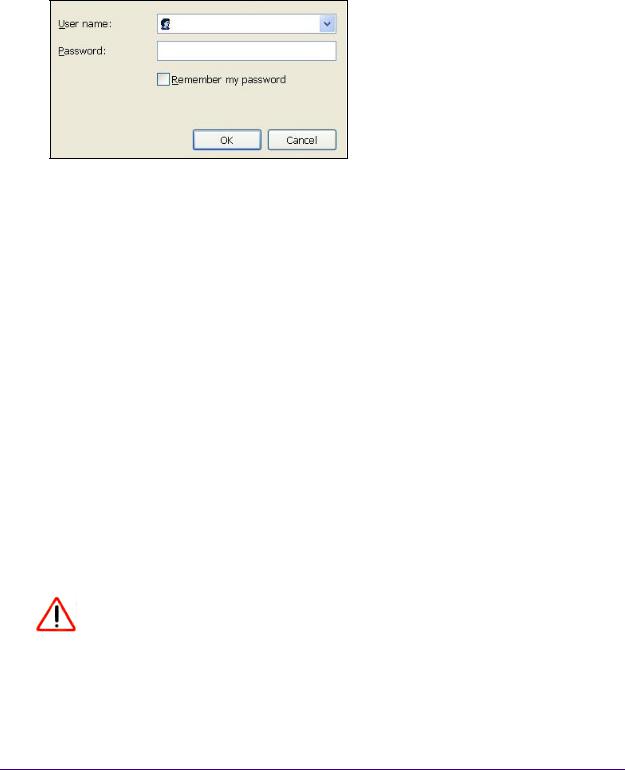
N300 Wireless Router WNR2000v4
To use NETGEAR genie again if you want to view or change settings for the router:
1.Launch your browser from a computer or wireless device that is connected to the router.
2.Type http://www.routerlogin.net or http://www.routerlogin.com. The login window displays:
admin
********
3.Enter admin for the router user name and password for the router password, both in lowercase letters.
Note: The router user name and password are different from the user name and password for logging in to your Internet connection. For more information, see Types of Logins and Access on page 17.
Upgrade Router Firmware
When you set up your router and are connected to the Internet, the router automatically checks for you to see if newer firmware is available. If it is, a message is displayed on the top of the screen. The message might be A router firmware upgrade is available, or a similar message.
To upgrade the firmware after the router has detected newer firmware and displays a message:
1.Click the message.
The Firmware Upgrade Assistant displays.
2.Click Yes.
The router upgrades to the latest firmware. After the upgrade, the router restarts.
CAUTION:
Do not try to go online, turn off the router, shut down the computer, or do anything else to the router until the router finishes restarting and the Power LED has stopped blinking and has turned to steady green for several seconds.
Getting Started with NETGEAR genie
19
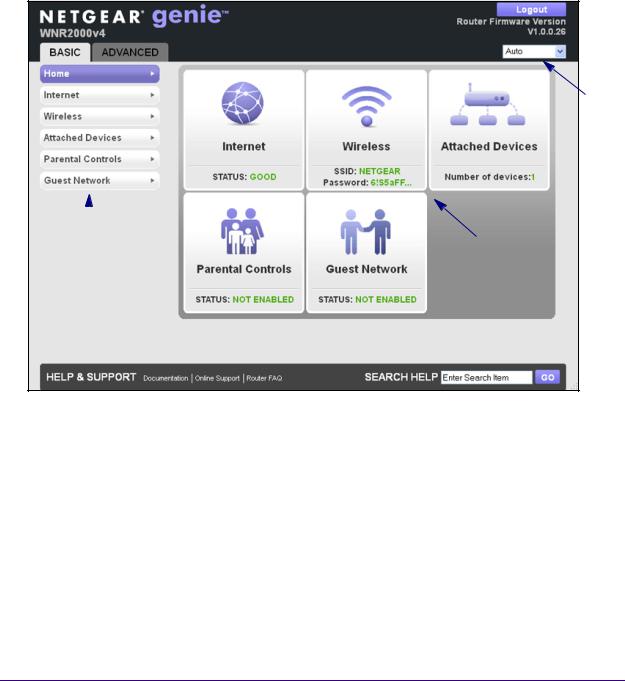
N300 Wireless Router WNR2000v4
For more information about upgrading firmware, see Upgrade the Router Firmware on page 74.
Router Dashboard (Basic Home Screen)
The router Basic Home screen has a dashboard that lets you see the status of your Internet connection and network at a glance. You can click any of the five sections of the dashboard to view more detailed information. The left column has the menus, and at the top is an Advanced tab that provides access to additional menus and screens.
Language
|
|
Dashboard |
Menus |
(Click to view |
|
(Click the |
details) |
|
Advanced tab |
|
|
to view more) |
|
|
 Help
Help
Figure 5. Router Basic Home screen with dashboard, language, and online help
Basic screen:
•Home. This dashboard screen displays when you log in to the router.
•Internet. Set, update, and check the ISP settings of your router.
•Wireless. View or change the wireless settings for your router.
•Attached Devices. View the devices that are connected to your network.
•Parental Controls. Download and set up parental controls to prevent objectionable content from reaching your computers.
•Guest Network. Set up a guest network to allow visitors to use your router’s Internet connection.
Getting Started with NETGEAR genie
20
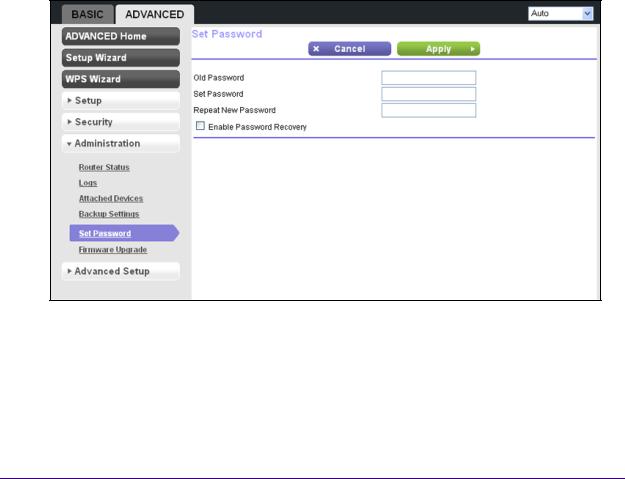
N300 Wireless Router WNR2000v4
Advanced tab. Set up the router for unique situations such as when remote access by IP address or by domain name from the Internet is needed. For more information, see Chapter 7, Advanced Settings. Using this tab requires a solid understanding of networking concepts.
Help & Support. Go to the NETGEAR support site to get information, help, and product documentation. These links work once you have an Internet connection.
Change the Password
The default password that you use to log in to the router is admin. NETGEAR recommends that you change this default password to a secure password.
Changing the default password is not the same as changing the password for wireless access. The label on the back panel of your router shows your unique wireless network name (SSID) and the passphrase (also referred to as the wireless network password or network key) for wireless access (see Label on page 12).
To change the default password that you use to log in to the router:
1.Select Advanced > Administration > Set Password. The Set Password screen displays:
2.Type the old password, and type the new password twice in the fields on this screen.
3.If you want to be able to recover the password, select the Enable Password Recovery check box.
For more information, see the following section.
4.Click the Apply button.
Getting Started with NETGEAR genie
21

N300 Wireless Router WNR2000v4
Password Recovery
NETGEAR recommends that you enable password recovery if you change the password for the router’s user name of admin. Then you have an easy way to recover the password if it is forgotten. This recovery process is supported in Internet Explorer, Firefox, and Chrome browsers, but not in the Safari browser.
To set up password recovery:
1.Select Advanced > Administration > Set Password. The Set Password screen displays.
2.Select the Enable Password Recovery check box.
3.Select two security questions and provide answers to them.
4.Click the Apply button.
When you use your browser to access the router, the login window displays. If password recovery is enabled, when you click the Cancel button, the password recovery process starts. You can then enter the saved answers to the security questions to recover the password.
Add Wireless Devices or Computers to Your Network
Choose either the manual or the WPS method to add wireless devices and other equipment to your wireless network. For information about how to set up a guest network, see Guest Network on page 38.
Manual Method
To connect manually:
1.Open the software that manages your wireless connections on the wireless device (laptop computer, gaming device, iPhone) that you want to connect to your router.
This software scans for all wireless networks in your area.
2.Look for your network and select it. If you did not change the name of your network during the setup process, look for the default WiFi network name (SSID) and select it.
The default SSID is located on the product label on the back panel of the router.
3.Enter the router wireless network password (passphrase) and click the Connect button.
The default router passphrase is located on the product label on the back panel of the router.
4.Repeat steps 1–3 to add other wireless devices.
Getting Started with NETGEAR genie
22

N300 Wireless Router WNR2000v4
Wi-Fi Protected Setup (WPS) Method
Wi-Fi Protected Setup (WPS) lets you connect to a secure WiFi network without typing its password. Instead, press a button or enter a PIN. NETGEAR calls WPS Push 'N' Connect.
During the connection process, the client gets the security settings from the router so that every device in the network has the same security settings.
Some older WiFi equipment is not compatible with WPS. WPS works only with WPA2or WPA wireless security.
To use WPS to join the wireless network:
1.Press the WPS button on the router front panel  . The WPS LED (on the button) starts to blink green.
. The WPS LED (on the button) starts to blink green.
2.Within 2 minutes, press the WPS button on your wireless device, or follow the WPS instructions that came with the device.
The device is now connected to your router.
3.Repeat steps 1–2 to add other WPS wireless devices.
Getting Started with NETGEAR genie
23
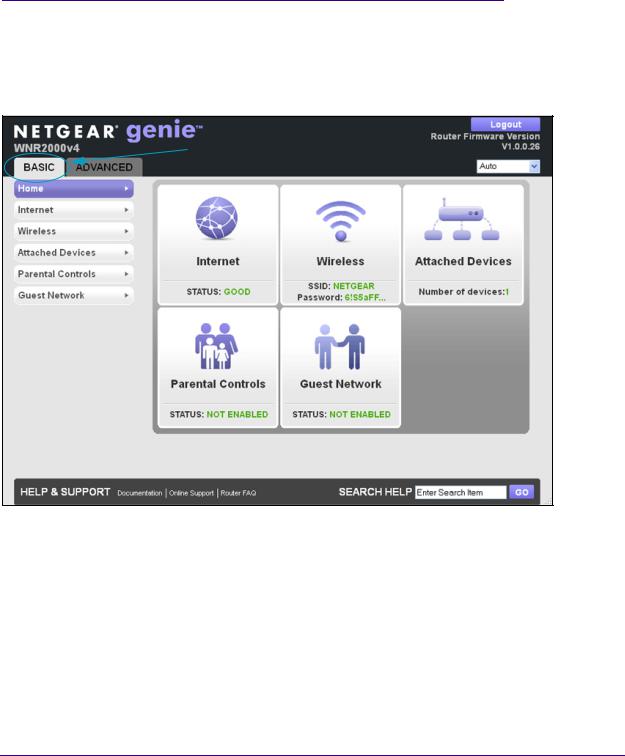
3. genie Basic Settings |
3 |
Your Internet connection and network |
This chapter describes the features that are available from the genie Basic Home screen:
Figure 6. genie Basic Home screen
This chapter contains the following sections:
•Internet Setup
•Basic Wireless Settings
•Attached Devices
•Parental Controls
•Guest Network
24
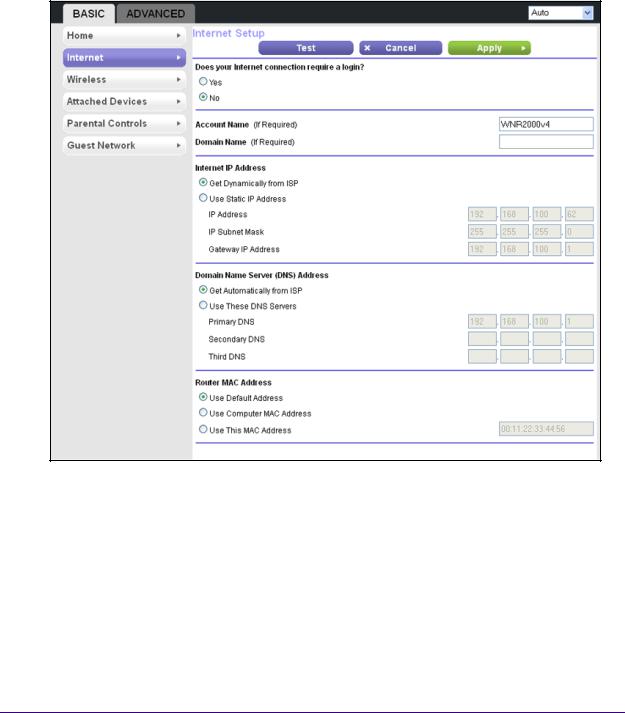
N300 Wireless Router WNR2000v4
Internet Setup
The Internet Setup screen is where you view or change ISP information.
To view or change the Internet setup:
1.From the Home screen, select Internet. The Internet Setup screen displays:
The fields that display in the Internet Setup screen depend on whether your Internet connection requires a login.
•Yes. Select the tunneling protocol, and enter the login name and password for your ISP. If you want to change the login time-out, enter a new value in minutes.
•No. Enter the account and domain names, only if needed.
2.Enter the settings for the IP address and DNS server.
The default settings usually work fine. If you have problems with your connection, check the ISP settings.
3.Click the Apply button.
genie Basic Settings
25

N300 Wireless Router WNR2000v4
4.Click the Test button.
Your Internet connection is tested. If the router does not detect the Internet connection and the NETGEAR website does not display within 1 minute, see Chapter 9, Troubleshooting.
Internet Setup Screen Fields
The following descriptions explain all of the possible fields on the Internet Setup screen. Note that which fields display on this screen depends on whether an ISP login is required.
Does Your ISP Require a Login? Select either Yes or No.
These fields display when no login is required:
•Account Name (If Required). Enter the account name provided by your ISP. This might also be called the host name.
•Domain Name (If Required). Enter the domain name provided by your ISP.
These fields display when your ISP does require a login:
•Internet Service Provider. As the ISP tunneling protocol, select PPTP, L2TP, or PPPoE.
•Login. Enter the login name provided by your ISP. This is often an email address.
•Password. Enter the password that you use to log in to your ISP.
•Service Name (If Required). Enter the service name provided by your ISP. If your ISP did not give you a service name, leave this field blank.
•Connection Mode. Select the one of the following connection modes:
-Always On. The connection automatically starts when you turn on the router and does not time out. If the connection is terminated for some reason, the router attempts to bring up the connection.
-Dial on Demand. The connection automatically starts when there is outbound traffic to the Internet and automatically terminates when the idle time-out period is exceeded.
-Manually Connect. You need to connect and disconnect manually. To connect to the Internet, click the Advanced tab to display the Internet Port pane, click the Connection Status button to display the Connection Status screen (see Connection Status on page 122), and then click the Connect button. The manual connection does not time out. To disconnect from the Internet, click the Disconnect button. The Connect and Disconnect buttons display only when the connection mode is Manually Connect.
•Idle Timeout (In Minutes). If you want to change the login time-out, enter a new value in minutes. This determines how long the router keeps the Internet connection active after there is no Internet activity from the LAN. Entering a value of 0 (zero) means never log out.
genie Basic Settings
26

N300 Wireless Router WNR2000v4
Internet IP Address.
•Get Dynamically from ISP. Your ISP uses DHCP to assign your IP address. Your ISP automatically assigns these addresses.
•Use Static IP Address. Enter the IP address, IP subnet mask, and the gateway IP address that your ISP assigned to you. The gateway is the ISP’s router to which your router should connect.
Domain Name Server (DNS) Address. The DNS server is used to look up site addresses based on their names.
•Get Automatically from ISP. Your ISP uses DHCP to assign your DNS servers. Your ISP automatically assigns these IP addresses.
•Use These DNS Servers. If you know that your ISP does not automatically transmit DNS addresses to the router during login, select this option, and enter the IP address of your ISP’s primary DNS server. If a secondary DNS server address is available, enter it also.
Router MAC Address. The Ethernet MAC address used by the router on the Internet port. Some ISPs register the MAC address of the network interface card in your computer when your account is first opened. They accept traffic only from the MAC address of that computer. This feature allows your router to use your computer’s MAC address (this is also called spoofing or cloning).
•Use Default Address. Use the default MAC address.
•Use Computer MAC Address. The router captures and uses the MAC address of the computer that you are now using to configure the router. To configure the router, make sure that you use the computer that is registered and allowed by the ISP.
•Use This MAC Address. Enter the MAC address that you want to use.
Basic Wireless Settings
The Wireless Settings screen lets you view or configure the wireless network setup.
The router comes with preset WPA2-PSK security. This means that the WiFi network name (SSID), wireless network password (also referred to as the passphrase or network key), and security option (authentication and encryption protocol) are preset in the factory. You can find the preset SSID and password on the back panel of the router. The preset SSID and password are uniquely generated for every device to protect and maximize your wireless security.
WARNING:
NETGEAR recommends that you do not change your preset security settings. If you do decide to change your preset security settings, make a note of the new settings and store it in a safe place where you can easily find it.
genie Basic Settings
27
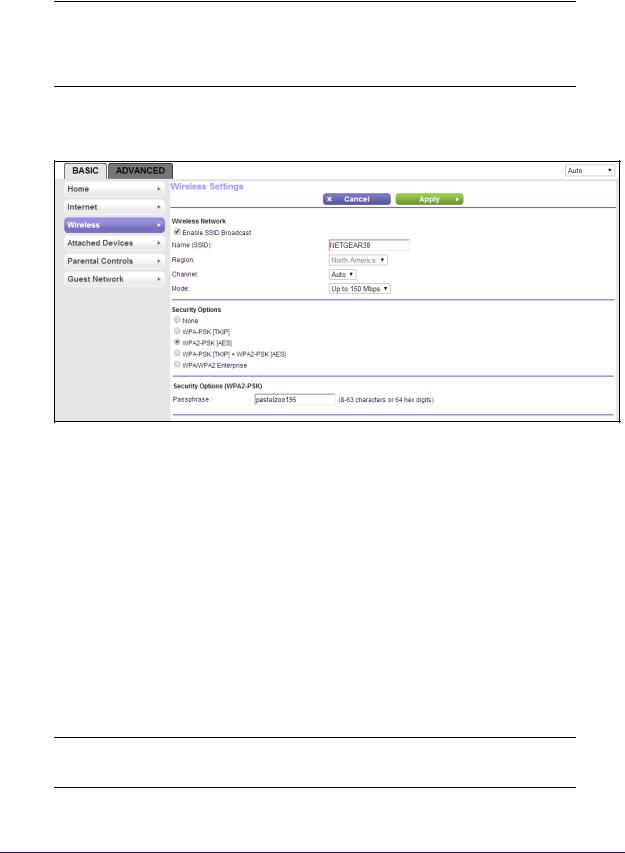
N300 Wireless Router WNR2000v4
Note: If you use a wireless computer to change the wireless network name (SSID) or other wireless security settings, you are disconnected when you click the Apply button. To avoid this situation, use a computer with a wired connection to access the router.
To view or change basic wireless settings:
1. On the Basic Home screen, select Wireless to display the Wireless Settings screen.
Note: The screen sections, settings, and procedures are explained in the following sections.
2.Make any changes that are needed.
3.Click the Apply button.
4.Set up and test your wireless devices and computers to make sure that they can connect wirelessly. If they do not, check the following:
•Is your wireless device or computer connected to your network or another wireless network in your area? Some wireless devices automatically connect to the first open network (without wireless security) that they discover.
•Does your wireless device or computer show up on the Attached Devices screen? If it does, then it is connected to the network.
•If you are not sure what the network name (SSID) or password is, look on the label on the back panel of your router.
Note: The WEP option displays only if you select Up to 54 Mbps from the Mode menu.
genie Basic Settings
28

N300 Wireless Router WNR2000v4
Wireless Settings Screen Fields
The following sections describe the fields of the Wireless Settings screen.
Wireless Network
Enable SSID Broadcast. This setting allows the router to broadcast its SSID so wireless stations can see this wireless name (SSID) in their scanned network lists. This check box is selected by default, but you can clear it to disable broadcast of the SSID.
Name (SSID). The SSID is also known as the wireless network name. The default SSID is randomly generated. NETGEAR strongly recommends that you do not change the default SSID. If you do decide to change the name, enter a 32-character (maximum) name in this field. This field is case-sensitive.
Region. The location where the router is used. Select from the countries in the list. Note that in the United States, the region is fixed to United States and is not changeable.
Channel. This setting is the wireless channel used by the gateway. Enter a value from 1 through 13. (For products in the North America market, only Channels 1 through 11 can be operated.) Do not change the channel unless you experience interference (shown by lost connections or slow data transfers). If this happens, experiment with different channels to see which is the best. The default setting is Auto, which means that the router selects a channel automatically.
Note: When you use multiple access points, it is better if adjacent access points use different channels to reduce interference. The recommended channel spacing between adjacent access points is 5 channels (for example, use Channels 1 and 6, or 6 and 11).
Mode. Up to 150 Mbps is the default setting. Up to 54 Mbps supports 802.11g, and 11b wireless devices. The 300 Mbps setting allows 802.11n devices to connect at this speed.
Security Options
The Security Options section of the Wireless Settings screen lets you change the wireless authentication and encryption option and the passphrase (also referred to as the wireless network password or network key). The security that you select encrypts data transmissions and ensures that only trusted devices receive authorization to connect to your network.
WARNING:
NETGEAR recommends that you do not change the wireless security option and the passphrase. However, if you need to change these settings, the following sections explains how. Do not disable wireless security!
genie Basic Settings
29
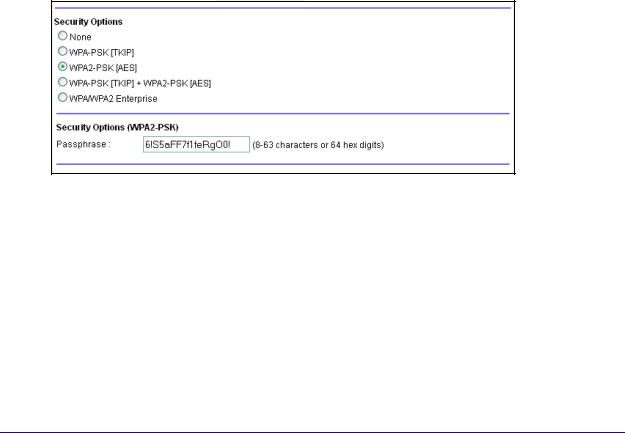
N300 Wireless Router WNR2000v4
WPA-PSK, WPA2-PSK, and WPA-PSK + WPA2-PSK Mixed
Mode
These types of wireless security options use a pre-shared key (PSK), which is the same as a passphrase, wireless network password, or network key.
You can select from the following wireless PSK security options:
•WPA-PSK [TKIP]. Wi-Fi Protected Access (WPA) provides strong data security with Temporal Key Integrity Protocol (TKIP) encryption. This option supports speeds of up to 54 Mbps only.
•WPA2-PSK [AES]. Wi-Fi Protected Access version 2 (WPA2) provides strong data security with Advanced Encryption Standard (AES) encryption. This is the preset wireless security that is enabled by default. WPA2 provides the most reliable security. This option supports speeds of up to 300 Mbps. If not all clients in your network support WPA2, select WPA-PSK + WPA2-PSK mixed mode.
•WPA-PSK [TKIP] + WPA2-PSK [AES]. WPA-PSK + WPA2-PSK is referred to as mixed mode, which supports a combination of TKIP and AES encryption for both WPA and WPA2 clients. For WPA clients, this option supports speeds of up to 54 Mbps only. For WPA2 clients, this option supports speeds of up to 300 Mbps.
To change the WPA wireless security option and passphrase:
1. In the Security Options sections of the Wireless Settings screen, select one of the WPA options with PSK.
2.In the associated Passphrase field, enter the passphrase that you want to use.
The passphrase is a text string from 8 to 63 ASCII characters or exactly 64 hexadecimal digits. A hexadecimal digit is one of the following characters: 0, 1, 2, 3, 4, 5, 6, 7, 8, 9, A, B, C, D, E, and F.
Wireless clients need to use the passphrase to access the wireless network through the router.
3.Click the Apply button.
genie Basic Settings
30
